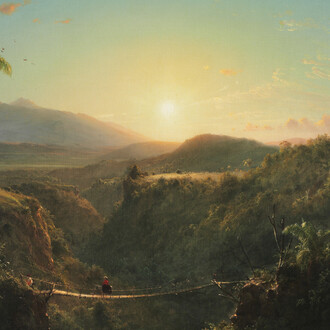The Canaan and Ancient Israel Gallery offers a historical overview of the region’s broad history (approximately 3500 BCE to 1200 BCE), which encompasses modern Israel, the West Bank and Gaza, Jordan and Lebanon, as well as adjacent parts of Syria. Bronze and Iron Age objects on display reveal the region's history of successive periods of occupation— most evident in the pottery vessels featured. Easily shaped and enduring, pottery provides a continuous record of changes in economic conditions, technology and social values. Central to the gallery is a full-scale diorama of a typical Iron Age house that portrays the various aspects of everyday life in the Levant from food production to storage. The Penn Museum holds the largest collection of artifacts from this region in the Western Hemisphere.
Canaan and Ancient Israel begins with an introduction to the geography of the Levant and the history of the Penn Museum’s excavations in the region. A series of display cases with artifacts typical of successive periods of occupation, e.g., Early Bronze, Middle Bronze, Late Bronze and Iron Ages, follows. The remainder of the gallery is organized thematically: politics and social organization; religion; domestic life, which includes a full-scale reconstruction of a typical Iron Age house, with its work/living space, stables and storeroom; agriculture and crafts; trade and commerce; personal appearance or clothing and cosmetics; and, death and burial.
The Penn Museum’s active interest in the Levant began in the 1920s, when Clarence Fisher, Alan Rowe and G. M. FitzGerald directed excavations, funded by John D. Rockefeller, at Tell el-Husn, ancient Beisan or Beth Shean, on whose walls the Philistines impaled the bodies of Saul and his sons following their defeat on Mount Gilboa (1 Samuel 31: 1-10). The Beth Shean excavations lasted from 1921 to 1933. Beginning in the mid-1950s James B. Pritchard directed work at el-Jib/Gibeon (1956-62), Tell es Sa’idiyeh (1964-68), probably ancient Zarenthan, where the Israelites crossed the Jordan (Joshua 3: 16), and Sarafand/Sarepta (1969-74). Museum researcher Patrick McGovern dug in the Baq’ah Valley (Jordan) in the late 1970s and early 1980s, and Bruce Routledge, formerly at the Penn Museum, undertook excavations at Khirbet al-Mudayna al-‘Aliya in the same country in the 1990s.
While the Penn Museum excavations account for the bulk of its collections, the Museum expanded its holdings in 1962 with the purchase of finds from Elihu Grant’s work at Ain Shemesh/Beth Shemesh, sponsored by Haverford College, in 1928-1933, and in 1997 by the acquisition of artifacts from William Morton’s excavations at Dhiban (1955-56 and 1965). Other sites represented in the collections are Mt. Carmel and Tell Hesban.
Though the Beth Shean excavations yielded substantial Roman and Byzantine remains, the Penn Museum's collections from the Levant date largely to the Bronze and Iron Ages. They illustrate the variety of artifacts characteristic of the area's successive phases of occupation, including domestic tools, weaponry, jewelry, cult and funerary objects, cosmetics, stone vessels and implements, and above all pottery--an abundant and durable source of information about the past.
Canaan and Ancient Israel Gallery displays artifacts from its excavations in the Levant. The title Canaan and Ancient Israel is drawn from ancient names of the region and its inhabitants. Canaan is the earliest attested name, found in texts, dated to the 18th century BCE, from Mari, on the Euphrates, near the border between Syria and Iraq. Canaan was not ethnically or politically unified, but its inhabitants shared similarities in language and culture and can be identified as Canaanites. Canaan was the land which the tribes of Israel conquered after the Exodus and Canaanites the people dispossessed.
Israel refers to a people within Canaan first attested in a stele of the late 13th century BCE Egyptian Pharaoh Mereneptah and to the later entity formed by those people. The Bible (Old Testament or Tanak) is concerned with the religious history of Israel.
The Bible is a key documentary source bearing on the region, but archaeology provides an important, and arguably more neutral, perspective derived from the material remains and their contexts. Looking at Canaan and Israel through the lens of archaeology shows us what shaped the identities of those who lived in the region in the ancient past.
















